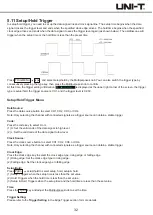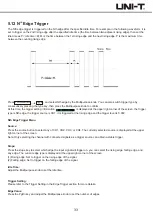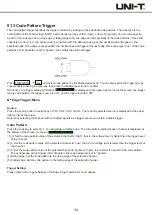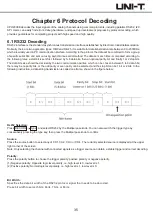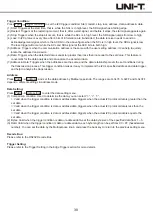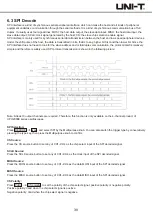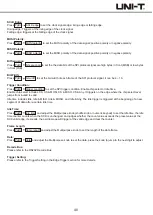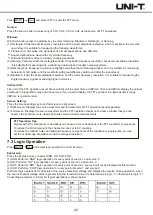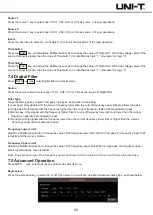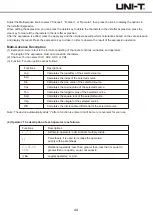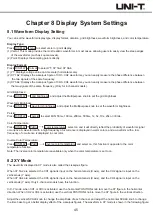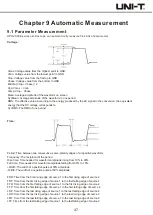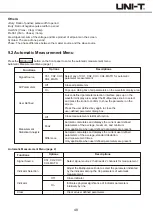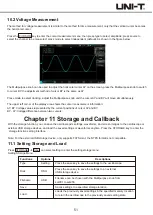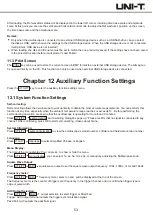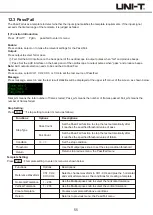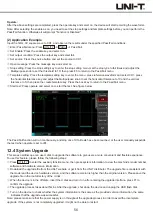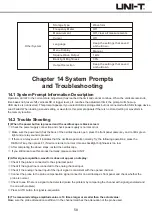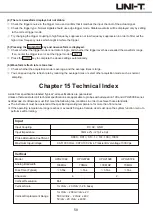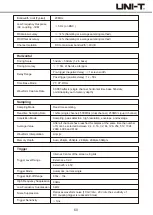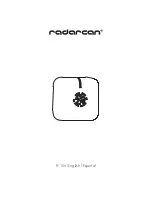
8.1 Waveform Display Setting
You can set the waveform display type, display format, duration, grid brightness, waveform brightness, and color temperature.
Display Type:
Press DISPLAY type to select vector or point display.
(1) Vector: This mode provides the most realistic waveforms in most cases, allowing users to easily view the steep edges
of the waveforms (such as square waves).
(2) Point: Displays the sampling points directly.
Display Format:
Press DISPLAY format to select YT, XY 1&2, XY 3&4.
(1) YT: Displays voltage value on time scale (horizontal scale).
(2) XY 1&2: Displays the Lissajous figure of CH1~CH2 waveforms, you can easily measure the phase difference between
the two signals of the same frequency.
(3) XY 3&4: Displays the Lissajous figure of CH3~CH4 waveforms, you can easily measure the phase difference between
the two signals of the same frequency. (Only for 4-channel models).
Grid Brightness:
Press DISPLAY grid brightness , and adjust the Multipurpose knob to set the grid brightness.
Waveform Brightness:
Press DISPLAY waveform brightness , and adjust the Multipurpose knob to set the waveform brightness.
Persist:
Press DISPLAY persist to select MIN, 50ms, 100ms, 200ms, 500ms, 1s, 5s, 10s, 20s or infinite.
Color Temperature:
Press DISPLAY PgDn
color temperature , select on and it will directly reflect the probability of waveform signal
occurrence. A waveform with a high frequency of occurrence is displayed in warm colors, and a waveform with a low
frequency of occurrence is displayed in cool color.
Inverse Color Temperature:
Press DISPLAY PgDn
inverse color temperature and select on, this function is opposite to the color
temperature function.
Note: The inverse color temperature is available only when the color temperature is set to on.
Chapter 8 Display System Settings
8.2 XY Mode
The waveform displayed in XY mode is also called the Lissajous figure.
When XY 1&2 are selected, the CH1 signal is input on the horizontal axis (X axis), and the CH2 signal is input on the
vertical axis (Y axis).
When XY 3&4 are selected, the CH3 signal is input on the horizontal axis (X axis), and the CH4 signal is input on the
vertical axis (Y axis). Only 4-channel models have this function.
In X-Y mode, when CH1 or CH3 is activated, use the horizontal POSITION knob to move the XY figure in the horizontal
direction. When CH2 or CH4 is activated, use the vertical POSITION knob to move the XY figure in the vertical direction.
Adjust the vertical SCALE knob to change the amplitude of each channel, and adjust the horizontal SCALE knob to change
the time base to get a better display effect of the Lissajous figures. The waveform in XY mode is shown in the following figure:
45
Summary of Contents for UPO2000E Series
Page 1: ...UPO2000E Series Ultra Phosphor Oscilloscope User Manual...
Page 66: ......


